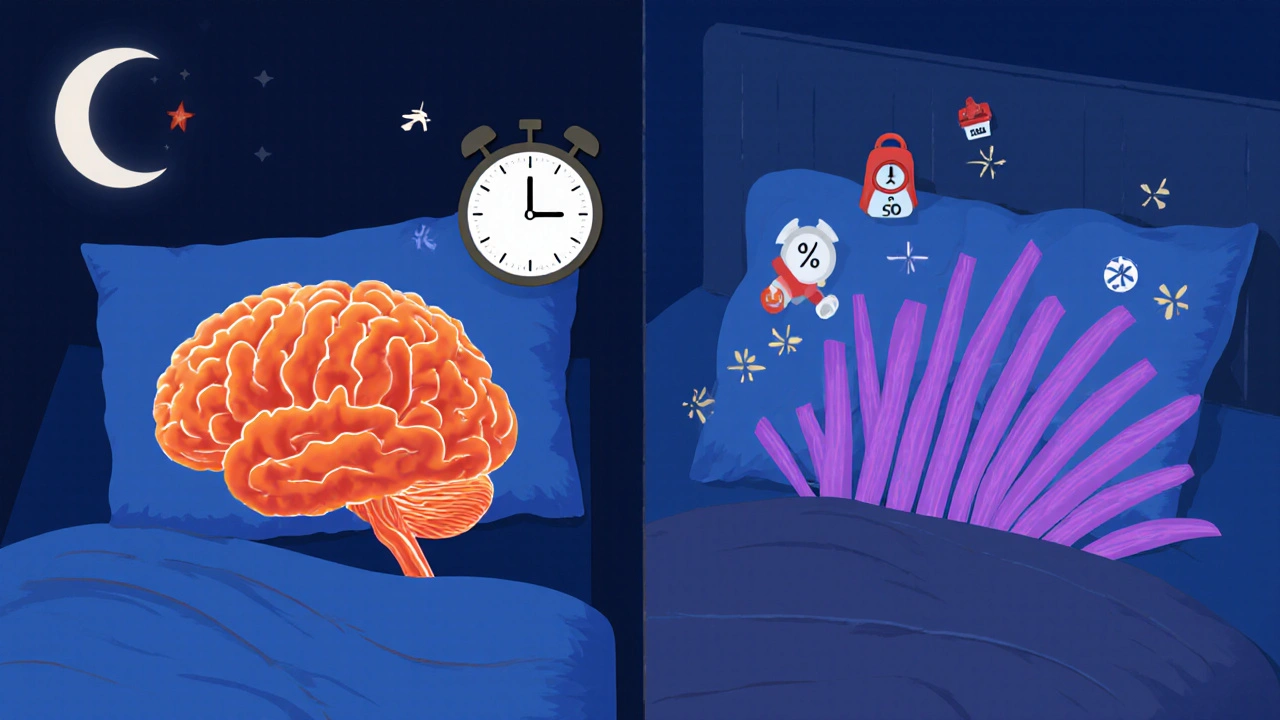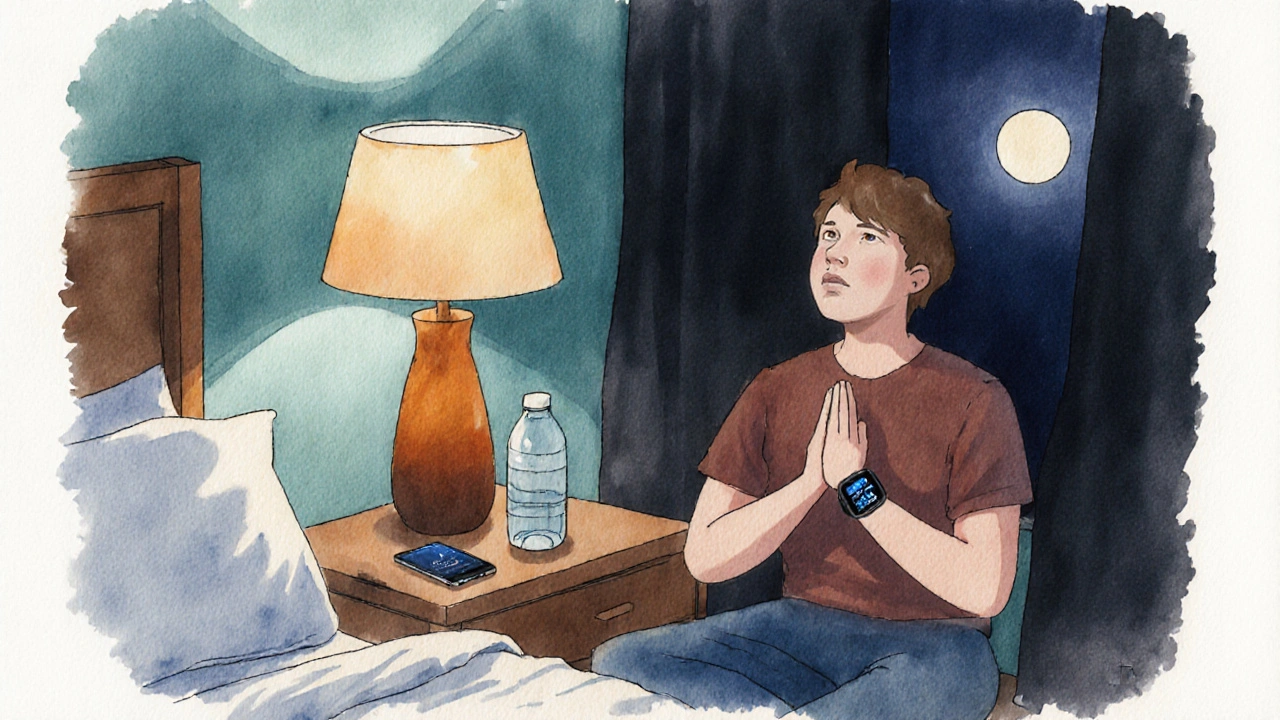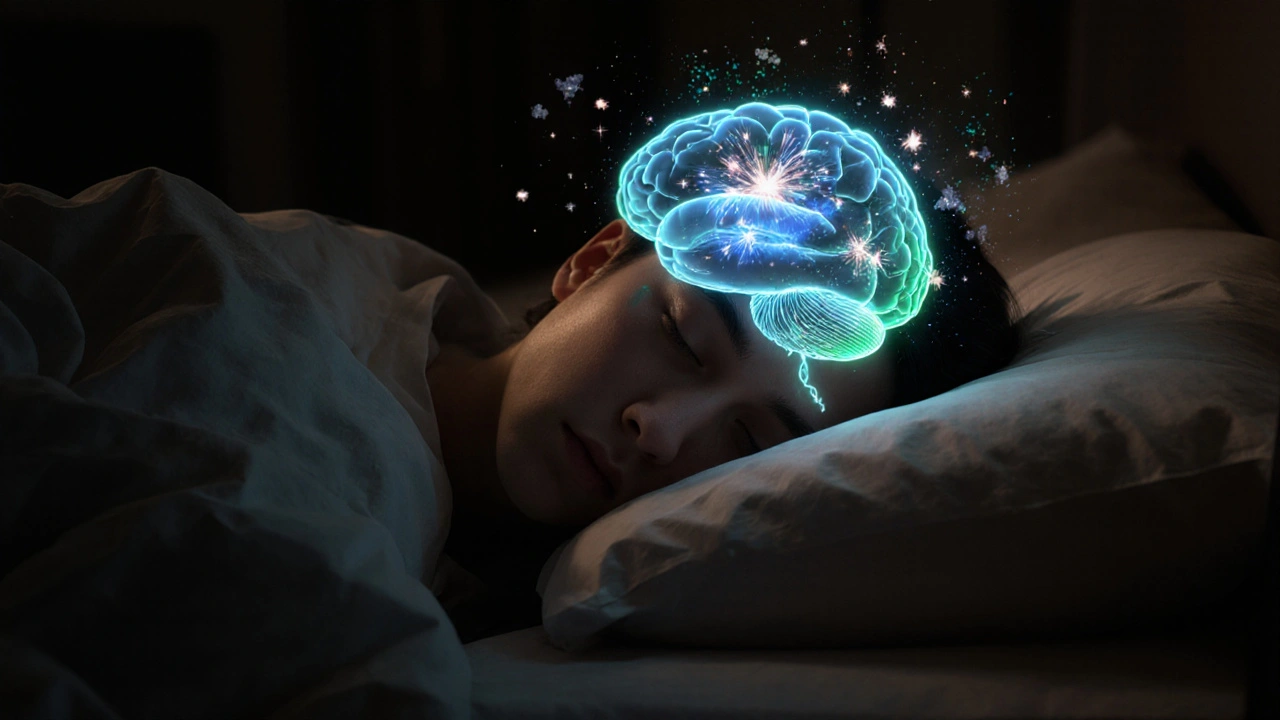REM Sleep & Mood Patterns Calculator
Compare REM Sleep Patterns
This tool compares typical REM sleep patterns in depression and anxiety conditions. Enter values to see how they relate to each condition.
Analysis Results
Interpretation Guide
- Short REM Latency (40–55 mins): Suggests depression-related pattern
- High REM Percentage (30–35%): Suggests depression-related pattern
- High REM Fragmentation (5–8 episodes/night): Suggests anxiety-related pattern
When it comes to the night’s most vivid dreams, REM sleep is a stage where the brain is almost as active as when you’re awake, yet the body stays still. That paradox makes REM sleep a hot topic for anyone dealing with mood swings, low energy, or racing thoughts. Below you’ll learn what REM sleep actually does, why it matters for depression and anxiety, and simple steps you can take to protect this crucial part of the night.
Key Takeaways
- REM sleep regulates emotion by replaying daytime experiences and resetting stress hormones.
- People with depression often enter REM faster and spend more time in the stage.
- Anxiety tends to shorten REM periods and increase nightly awakenings.
- Improving sleep hygiene, managing light exposure, and considering therapy can restore healthier REM patterns.
- Tracking sleep with a wearable or diary helps you see the link between mood and REM.
How REM Sleep Works
The sleep cycle repeats every 90‑100 minutes and includes light sleep (N1, N2), deep slow‑wave sleep (N3), and REM. The brain’s sleep cycle a sequence of stages that repeats throughout the night shifts each night: early cycles have more deep sleep, later cycles become richer in REM.
During REM, the brain fires a burst of activity in regions like the amygdala (emotion) and the prefrontal cortex (decision‑making). At the same time, neurotransmitters such as serotonin and norepinephrine dip, which allows the brain to process emotions without the usual “brakes.” This biochemical cocktail is why REM is linked so tightly to mood.
Two hormones deserve special mention. Cortisol the primary stress hormone that peaks in the early morning drops during the night, and a proper decline helps REM settle. Melatonin a hormone that signals darkness to the body rises in the evening and creates the environment where REM can flourish.

REM Sleep and Depression
Research shows that people with major depressive disorder often experience “REM latency” - the time it takes to hit the first REM period - that’s shorter than in healthy sleepers. Instead of the usual 90‑minute gap, many depressed patients slip into REM after just 40‑50 minutes. This early onset is linked to higher nighttime levels of cortisol and lower serotonin.
Another hallmark is an increased proportion of the night spent in REM. While a typical adult spends about 20‑25% of total sleep time in REM, depressed individuals may hover around 30‑35%. The excess REM time is thought to replay negative memories nonstop, which can deepen the feeling of hopelessness.
Antidepressant medications, especially selective serotonin reuptake inhibitors (SSRIs), often lengthen REM latency and reduce the overall REM percentage. That shift is one reason many patients report feeling “more rested” after a few weeks of treatment, even if total sleep time hasn’t changed much.
REM Sleep and Anxiety
Anxiety disorders paint a different REM picture. Rather than an early start, anxious sleepers tend to have fragmented REM. Nighttime awakenings spike, breaking REM bouts into shorter episodes that never reach the depth needed for emotional processing.
These interruptions keep cortisol from falling to its lowest point, leaving the body in a semi‑alert state. The result is a feedback loop: anxiety raises cortisol, which disrupts REM, which then fails to calm the amygdala, perpetuating worry.
People with generalized anxiety disorder (GAD) often report a lower total REM percentage-sometimes under 15%-and a higher “REM fragmentation index.” This metric, measured by polysomnography, counts how many times REM is broken up each night. The more splits, the poorer the emotional reset.

Where Depression and Anxiety Overlap
Both conditions share a core problem: the brain’s inability to regulate stress hormones during the night. Whether REM starts too early (depression) or gets chopped up (anxiety), the end result is a mood that feels stuck.
To illustrate the differences, see the table below.
| Metric | Depression | Anxiety |
|---|---|---|
| REM latency (minutes) | 40‑55 (shortened) | 80‑100 (typical or lengthened) |
| % of total sleep in REM | 30‑35 (elevated) | 15‑20 (reduced) |
| REM fragmentation (episodes/night) | 2‑3 (moderate) | 5‑8 (high) |
| Morning cortisol spike | Elevated | Elevated |
Practical Ways to Protect REM Sleep
Knowing the science is useful, but real change comes from daily habits. Below is a checklist you can paste on your phone or bathroom mirror.
- Turn off bright screens at least an hour before bed. Blue‑light filters on phones help keep melatonin production on track.
- Stick to a regular bedtime, even on weekends. Consistency trains the body’s internal clock, smoothing the transition into REM.
- Avoid caffeine after 2p.m. and limit alcohol to one drink; both can suppress REM or cause early awakenings.
- Create a cool, dark room (around 65°F). Darkness cues melatonin, while cool temperatures support deep sleep that precedes REM.
- Consider a short, 20‑minute evening walk. Light exercise reduces cortisol without overheating the body.
- If racing thoughts keep you up, try a 5‑minute mindfulness session focused on breath. This can quiet the amygdala and improve sleep onset.
- Track your sleep with a wearable or a paper diary. Look for patterns: do stressful days correlate with fewer REM minutes?
- When mood stays low despite good sleep hygiene, discuss REM‑targeted therapy with a clinician. Cognitive Behavioral Therapy for Insomnia (CBT‑I) and certain antidepressants can specifically normalize REM patterns.
Frequently Asked Questions
Can I increase my REM sleep without medication?
Yes. Consistent sleep schedules, limiting screen time, and controlling bedroom temperature are the most effective natural ways to boost REM. Regular exercise, especially in the morning, also helps regulate the hormones that shape REM cycles.
Why do antidepressants change my dreaming?
Most antidepressants raise serotonin levels, which in turn lengthen REM latency and lower the total REM percentage. The result is fewer vivid dreams, which many patients interpret as feeling more rested.
Is it normal to feel groggy if I miss REM?
Missing REM can leave the brain without its nightly emotional reset, leading to mental fog, irritability, and a heavier‑than‑usual mood. That’s why people who repeatedly cut REM short often report feeling “off” the next day.
How does stress affect REM sleep?
Elevated cortisol keeps the brain in a semi‑alert state, shortening REM periods and increasing awakenings. Managing stress through meditation, exercise, or counseling can lower cortisol and restore a healthier REM profile.
Should I get a sleep study if I suspect REM problems?
If mood issues persist despite good sleep hygiene, a polysomnography (sleep study) can map your REM latency, percentage, and fragmentation. The data helps doctors pinpoint whether a sleep disorder or a mental‑health condition is at play.


Neviah Abrahams
Wow this tool looks slick but the code is a mess the logic is broken the if statements use single equals instead of double and that will never work we need proper validation and clear thresholds for REM latency and percentage
Uju Okonkwo
Hey, don’t get discouraged! This calculator can still be a useful starting point. You can manually adjust the thresholds based on recent research and use the results as a conversation starter with your clinician.
allen doroteo
I have to say the whole REM analysis here feels half‑baked.
The author forgot the most basic comparison between healthy sleepers and patients.
Without a proper control group the numbers are just guesses.
Even the UI looks like a rushed homework project.
You can’t trust a tool that uses “if (latency = 40)” inside the script.
That single equals is an assignment, not a comparison, so the condition never triggers.
The result section always prints “Normal” no matter what you put in.
If you entered 20 minutes you’d still see “Normal” and that’s misleading.
Researchers have shown that short REM latency correlates with depression, but the calculator never flags it.
Similarly high REM percentage is a marker, yet the tool hides it.
The fragmentation metric is also ignored because the code mixes up the variables.
I tried entering 6 episodes and got “Normal” again, which is absurd.
The whole thing needs a proper statistical model and peer review.
Until then treat it as a toy, not a diagnostic device.
So, double‑check everything and don’t let a buggy widget replace a real sleep study.
Corey Jost
Listen, the premise that REM patterns alone can diagnose depression is oversimplified; many factors like medication, age, and comorbid disorders modulate REM architecture, so relying on a single calculator is risky. Moreover, the tool doesn’t account for sleep continuity or stage transitions, which are crucial in clinical assessments. While it’s a neat visual, it should be paired with polysomnography and a thorough psychiatric evaluation. Otherwise you’re just reading numbers without context, and that can lead to misinterpretation.
Nick Ward
Great attempt at making REM data accessible! 😊 The layout is clean and the guide helps newbies understand the basics. Just remember it’s a supplement, not a substitute for professional advice.
felix rochas
Seriously, who designed this?! It’s obviously part of the pharma agenda!!! They want us to believe that a simple app can replace a full sleep study, so they can push drugs that target REM without proper oversight!!! Do the math-if you can’t even get the conditional logic right, why trust the conclusions? This is a classic distraction tactic!!!
inder kahlon
For anyone looking to improve the accuracy, consider adding a baseline night of untreated sleep and compare it to a post‑treatment night. That way you can see true shifts in latency, percentage, and fragmentation.
Dheeraj Mehta
Nice point! 🙃 Just keep in mind individual variability-what’s normal for one person might be abnormal for another.
Oliver Behr
Quick tip: keep the room dark and cool to maximize REM quality.
Tiffany W
Utilizing neurophysiological biomarkers without rigorous validation constitutes a pseudo‑evidence paradigm.
Rajeshwar N.
While I get the enthusiasm for DIY sleep analytics, it’s worth noting that REM metrics can be influenced by so many external variables that a three‑field calculator may oversimplify the picture. Still, for self‑monitoring it’s a fun start.
Louis Antonio
Yo, I’m not saying it’s broken, but don’t let a glitchy script replace a real sleep study, you feel me?
Kyle Salisbury
Interesting approach, but cultural differences in sleep patterns could affect the baseline data.
Angie Robinson
Really? You think a three‑input form can capture the complexity of psychiatric disorders? That’s naive. The tool ignores comorbidities, circadian rhythm disorders, and lifestyle factors. It’s dangerous to present this as reliable.
Emmons Kimery
Hey folks! If you’re new to tracking REM, start with consistent bedtime and record your numbers here for a week. Then we can discuss patterns and what they might mean. 🌟
Mimi Saki
Thanks for sharing! 😊 Keep it up and you’ll soon see the trends become clearer.